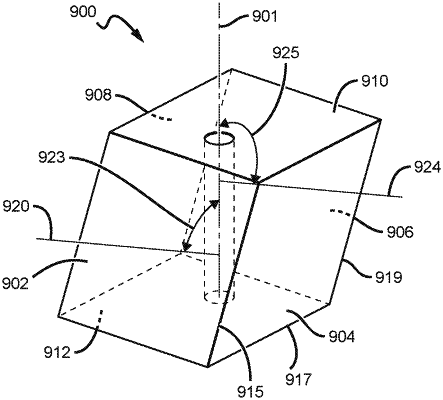| CPC G01S 7/4817 (2013.01) [G01S 7/4813 (2013.01); G01S 7/4865 (2013.01); G01S 17/931 (2020.01)] | 25 Claims |

|
1. A light detection and ranging (LiDAR) scanning device, comprising:
a first mirror disposed to receive one or more light beams, wherein the first mirror is a galvanometer mirror controllable to oscillate about an axis of the first mirror;
a polygon mirror optically coupled to the first mirror to receive the one or more light beams, wherein the polygon mirror comprises a plurality of reflective facets, wherein at least one of the plurality of reflective facets is associated with a tilt angle that is different from tilt angles of other reflective facets, the tilt angles of reflective facets being respective angles between normal directions of respective reflective facets and an axis about which the polygon mirror is rotatable, and wherein a difference of the tilt angles has an absolute value of at least 10 degrees,
wherein for at least two of the plurality of reflective facets, each reflective facet is arranged such that:
a first edge, a second edge, and a third edge of the reflective facet correspond to a first line, a second line, and a third line,
the first line and the second line intersect to form a first internal angle of a plane comprising the reflective facet, the first internal angle being an acute angle,
the first line and the third line intersect to form a second internal angle of the plane comprising the reflective facet, the second internal angle being an obtuse angle;
wherein the combination of the first mirror and the polygon mirror, when at least the polygon mirror is rotating, is configured to:
steer the one or more light beams both vertically and horizontally to illuminate an object within a field-of-view,
obtain return light formed based on the steered one or more light beams illuminating the object within the field-of-view, wherein the plurality of reflective facets comprises a first reflective facet associated with an acute tilt angle and a second reflective facet associated with an obtuse tilt angle, wherein the first reflective facet facilitates generating of LiDAR scan lines corresponding to a first part of a vertical field-of-view; and wherein the second reflective facet facilitates generating of LiDAR scan lines corresponding to a second part of a vertical field-of-view; the first part of the vertical field-of-view and the second part of the vertical field-of-view being at two ends of the vertical field-of-view, and
redirect the return light to an optical receiver disposed in the LiDAR scanning device.
|